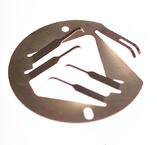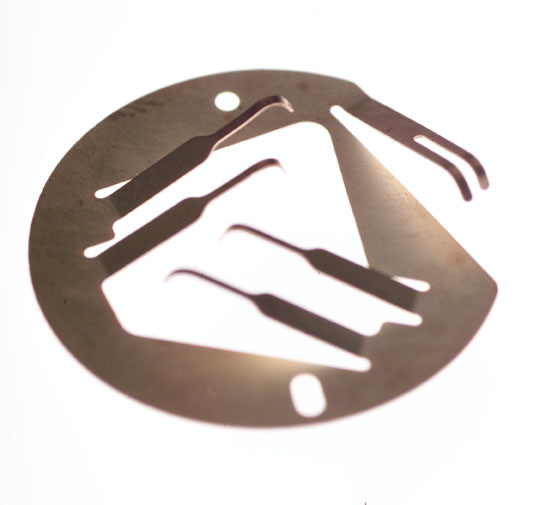Essential Things to Know about Photo Etching
Why Metal thickness Matters so much in Etching

Metal thickness determines the minimum feature size that can be etched, and dimensional tolerances determine the sheet size. The thing to remember is that etching is very much like erosion. Think of the Grand Canyon: it's 300 yards wide at the bottom and 10 miles wide at the top. And, the same kind of tapering walls a canyon has are also created in the etching process.
Here are some key design rules to keep in mind:
- Minimum holes or slot dimension is 110% of metal thickness
- Minimum ligature or land area is, generally, not less than metal thickness
- Minimum dimensional tolerance is +/-15% of thickness, to a practical minimum of +/-.0015" on metals .010" and less.
- Minimum radius dimensions are not less than 70% of metal thickness
- Etching speed is .001" -.002" per minute, depending on the alloy, and thus determines the total etching time.
Here's a link to a 3-minute video that shows the process step-by-step
For commercial photo etching facilities, the most widely used etching solution is ferric chloride. This chemistry has been optimized to be very efficient in etching a broad selection of metal alloys used in a host of industrial applications. Here's a quick rundown of the mostly widely used materials.
What Popular Metals Can Be Etched by Ferric Chloride?
- Carbon, Spring, Stainless and Silicon Steels
- Nickel, Nickel-Iron (Including Kovar, but not Havar), and Nickel-Copper
- Copper, Brass, Bronze (phosphor and Muntz)
- Aluminum (not anodized), Tin, Manganese, Zinc, Chromium, Indium
- Some "Super Alloys"
- Inconel 600 and X750
- Hastelloy X, A214
Here's a more extensive list of metals that can be etched in ferric chloride
What Metals Will Not Etch in Fe3Cl?
- Gold, Platinum, Palladium, Silver*
- Titanium, Tungsten, Tantalum
- Niobium, Zirconium
- Cobalt, Molybdenum*
* Conard has an alternative etchant for silver and moly.
How are Photo Etching Costs Determined?
Photo etching costs are about the "real estate": how many parts can fit on a sheet. The size of the sheet is, to a large degree, determined by the dimensional tolerances. Part designs that accommodate standard drawing block tolerances of +/-.005" on three-place decimals for metals up to .032" thick allow using the largest sheet size, often up to 18" x 24".
The "sheet" is the primary unit of labor, regardless of its size. Every sheet is handled into and out of each of ten sequential operations. The goal is to maximize the number of parts processed at each step, thereby reducing the labor per part.
The other significant cost variable is metal thickness. Thicker materials take longer to etch, which is the most expensive part of the process.
This chart illustrates the relationship between tolerances and costs.
How much do holes cost?
The first hole is always included in the price of the part. Any additional holes, no matter how many are FREE. Always.

Is photochemical machining a Nadcap special process?
No. Etching does not alter the mechanical or chemical properties of metal, therefore it does not qualify as a special process. However, chemical milling can be used to alter metal characteristics and in some cases may be subject to Nadcap checklist 7108/5 criteria.
What will my parts cost to be photo etched?
Get a FREE quote today!



